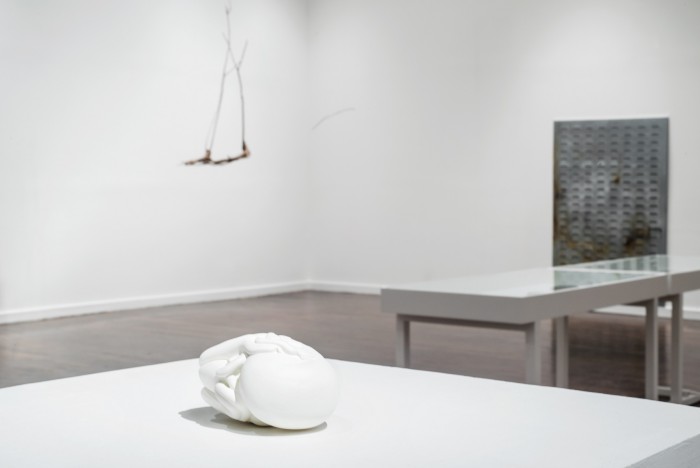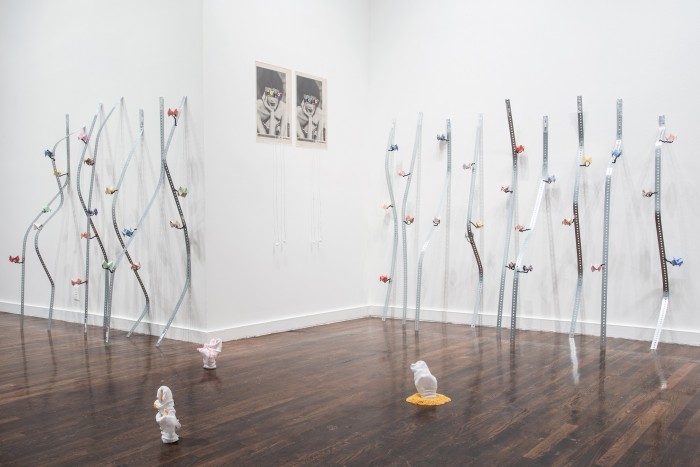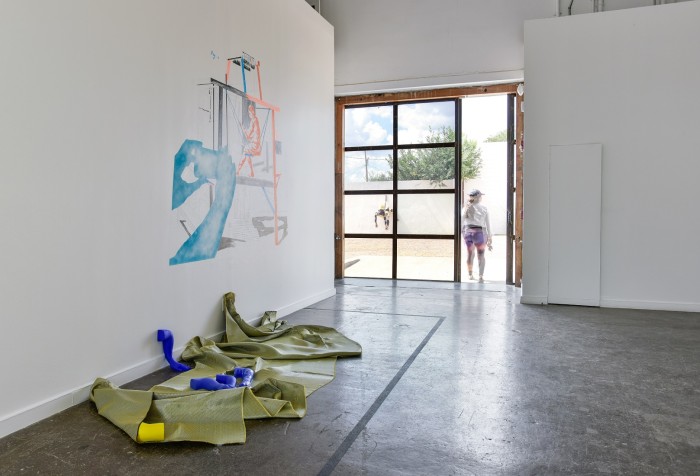Tiempo de lectura: 8 minutos

12.12.2015
Ballroom Marfa, Marfa, Texas, USA
25 de septiembre de 2015 – 14 de febrero de 2016




This is a show about the mammalian hand, and the tools it touches, holds and uses. Taking its title from the name of a fictional, post-iPhone device at the centre of Gary Shteyngart’s 2010 near-future novel Super Sad True Love Story, Äppärät is concerned with labor, play and the uncertain zone between the two; with the extension of the body, and the self, through technologies ancient and contemporary; with things (to borrow Martin Heidegger’s formulation) “present-at” and “ready-to” hand; with compulsion and with death.
Äppärät begins with Jessie Flood-Paddock’s Just Loom (2015), a wall painting-cum-sculpture based on an illustration of a worker operating a loom from Denis Diderot’s Encyclopédie (1751-72), one of the first attempts to record and systematize all human knowledge in published form. Writing on this image in his 1964 essay The Plates of the Encylopedia, Roland Barthes observed that the operator of this proto-industrial machine is ‘not a worker but a little lord who plays on a kind of technological organ [who] produces an extremely fine web’. Just Loom combines this Enlightenment-era depiction of labor (or is it leisure?) with a very 21st-Century sculptural tableau, in which a bolt of mesh-like Kevlar fabric becomes the ground for several rubberized casts of the artist’s hand and forearm. Looking at Flood-Paddock’s work, we might think of a contemporary ‘prosumer’ prodding at his or her smartphone, leaving a meniscus of greasy residue on its screen as they do work disguised as play.
From the Stone Age to the digital age, from the pre-human to the post-human, Äppärät suggests not only a neglected history of touch, and of tools, but also how this might help us arrive at what Barthes termed “a certain philosophy of the object”. Originally conceived to hang from the ceiling of Sigmund Freud’s study in Hampstead, North London, Damián Ortega’s The Root of the Root (2011-13) is a sculpture formed from implements created by a community of chimpanzees in the Gashaka-Gumti National Park, Nigeria, gathered by the artist on a research trip in the company of a group of UCL primatologists. (While tool use is common in the animal kingdom, from insects to crustaceans, birds to monkeys, their symbolic use is restricted to the higher apes). If we might read this work, as Ortega has said, as an index of how “the hand transforms nature”, it is also a technological precursor to the objects displayed by Shimabuku in a pair of museum-like vitrines entitled Oldest and Newest Tools of Human Beings (2015). Here, Neolithic hand-axes are set beside web-enabled Apple products of the same dimensions – tools created by members of the same species, albeit millennia apart. The artist’s deadpan presentation inevitably invites questions: which technology might be more usefully substituted for the other, which will persist the longer, which constitutes the greater evolutionary leap? In the Ballroom’s North Gallery, Marlie Mul presents a pair of sculptures that take the form of oversized steel grills, of a type commonly used by street smokers to stub out their cigarettes. Burned, ash-smeared, nicotine stained and stuck with discarded butts, these compositions prompt thoughts about our addiction to handheld ‘devices’ (whether they deliver nicotine, or a constant stream of data), and their inevitable passage from pristine objects of desire to (self-) disgusting trash. Mul has also created an onsite intervention at the Ballroom, Cigarette Ends Here (2015), using spent cigarettes gathered from the Marfa bar, The Lost Horse.
Hung at the artist’s eye-level, Melvin Edwards’ ‘Lynch Fragments’ sculptures reconfigure vicious looking pieces of hardware into forms that recall both histories of (sometimes enforced) labour, and exhibits in an ethnographic museum. His key piece Ogun Again (1988) takes its title from the Yoruba spirit of metal work (also celebrated in the Caribbean Santerìa and Vodoun traditions), its components speaking, as the artist has said, of “how Ogun is related to all tools”. If Edwards’ sculptures suggest that human technologies might be imbued with a kind of quasi-animist life force, so too in its way does Lee Lozano’s painting No title (ca. 1963-4). Here, an anthropomorphic hammer appears to engage in an impossible autoerotic act: its bulbous head penetrating the narrow cleft between its own claws. We get to thinking of cold, still metal transformed into hot and busy flesh – of tools behaving like bodies, and bodies behaving like tools.
The hand, in Äppärät, is a central motif, giving many of the works their scale, and can be imagined as kind of mouse cursor, manipulating information on the interface of the show (the Latin word ‘cursor’ translates as ‘runner’ or ‘errand boy’, a kind of spatial and temporal auxiliary). At once the silvered remains of a martyred saint, and an amputated cyborg’s limb, Paul Thek’s Untitled (from the series Technological Reliquaries) (ca.1966-67) points to enduring fantasies of the meeting of man and metal, and of how technology might protect, preserve, or even reanimate our fragile bodies. While Charles Ray’s sculpture of an avian embryo, Handheld Bird (2006), does not feature the cupped palm suggested by its title, it nevertheless provokes us to meditate – through linguistic suggestion, and more importantly through its sequencing of form and space – on the indivisibility of the holder and the held. Equally enigmatic, Trisha Donnelly’s photograph The Hand that Holds the Desert Down (2002) – a work making its second appearance at the Ballroom, following its inclusion in the 2008 group show ‘Every Revolution is a Roll of the Dice’ – is a close-up of the lifeless stone back paw of the Great Sphinx of Giza. We might ask ourselves why the artist has insisted that this leonine appendage is a ‘hand’, and what miracle or disaster would take place if it were, against all logic, to be raised. In Sophocles’ Oedipus Rex (ca. 492 BC) the Sphinx’s primary tool – what makes her part human – is, of course, language. Is Donnelly’s title a riddle, then, or something closer to a spell?
In Roger Hiorns’ Untitled (2011), the artist invites visitors to the Ballroom to chill their hands in a domestic freezer, the better to contemplate a series of paintings made with liquidized cows’ brains. Performed on the exhibition’s opening night by a naked youth, this is a ritual of uncertain purpose. Viewing Hiorns’ canvases, our numb digits slowly warming, we might interpret the washes of brain matter as an allusion to both the blinking out of consciousness at the moment of death, and to incidences of Creutzfeldt-Jakob disease in abattoir workers exposed to bovine cerebral tissue – an effacement of the self by the violence of Capital. In the Ballroom’s courtyard, Hiorns presents a newly commissioned work, A retrospective view of the pathway (falling sculpture) (2010-2015). Here, a headless figure – formed from a prosthetic used in a recent, high profile action film and stuffed with pages from Martin Heidegger’s Being and Time (1927) – is suspended from an electromagnet. At certain intervals, the magnet cuts out, and the figure plunges to the ground. One coordinate here might be Heidegger’s contention that the human subject (or Dasein) is ‘thrown’ arbitrarily into the world. Another might be Søren Kierkegaard’s concept of the ‘leap of faith’.
Sophie Jung’s new body of sculpture and performance work made in response to Äppärät creates an associative chain between – among other seemingly disparate phenomena – handheld origami fortune telling devices; hand-woven (and hence ‘unique’) Ikea rugs produced in the developing world; hand gestures that indicate money, salt, resistance and digital navigation; sock puppetry, online and offline; ‘life hacks’ involving fixing drowned iPhones with dry rice; ‘deskilling’ in manual labour and in art; repetitive strain injuries; toxic ‘e-waste’; and Lady Macbeth’s “out damned spot!” speech. Her sculptures are accompanied by spoken narratives, which visitors are invited to listen on a series of iPod shuffles mounted on twin newspaper ads for outmoded cell phones. At the opening of Äppärät, she performed the work Operation Earnest Voice (2015).
In Ed Atkins’ high definition CGI film Even Pricks (2013), we see human – and simian – thumbs inflate and deflate, seemingly operating as an index of (digital) attention, the compulsive and destructive ‘economy of like’. Snatches of music, speech, and invented promo slogans interrupt what the artist has called his “super-viciously artificial” imagery, while the real makes a return of sorts both in the film’s atmosphere of lingering, subcutaneous depression, and in its meticulously animated lens flares and moments of fuzzy ‘cinematography’ – reminders of a tool, the camera, which has played almost no part in its creation. Cécile B. Evans’ film installation Hyperlinks or it didn’t happen (2014) also explores questions of how new technologies impact on representation, and on what constitutes a self. At is centre is PHIL, a CGI rendering of the late actor Philip Seymour Hoffmann, who haunts a world he thought he’d departed like a restless ghost. Featuring a cast of very 21st-Century lost souls – from a Reddit user who claims his deceased girlfriend still posts on Facebook, to an Invisible Woman permanently slicked with green screen paint – this is a work about the physicality of data, and the digital afterlife.
During Äppärät’s run, a specially commissioned short story by Ned Beauman – author of the novels Boxer, Beetle (2010), The Teleportation Accident (2012) and Glow (2014) – will be broadcast on Marfa Public Radio KRTS 93.5 FM during December 2015 and January 2016. Entitled Workspace Ergonomics Assessment, the story explores tool use among animals, from ravens to crabs, over five daily instalments.
Courtesy of Ballroom Marfa
Comentarios
No hay comentarios disponibles.